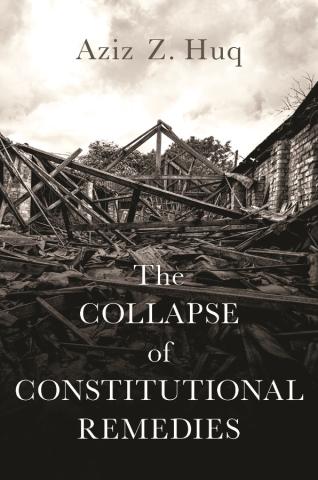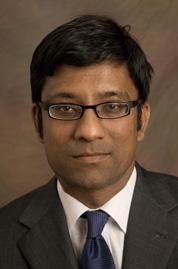Unraveling an American Story
Upcoming book event: Professor Aziz Huq will discuss The Collapse of Constitutional Remedies at 6 p.m. on February 9 at a virtual event hosted by the Seminary Co-op. Register here.
Professor Aziz Huq set out to write his newest book, The Collapse of Constitutional Remedies, prepared to confront revered narratives about the federal judiciary—a project that meant taking on ideals that had once occupied a cherished spot in his own conception of the American legal system.
His aim was to offer a deeper and more nuanced account than the “haloed imagining” Americans knew and scholars lauded. The story of the federal courts as politically independent protectors of individual rights felt out of sync with recent US Supreme Court rulings that shielded police and other state actors from civil claims of abuse.
In fact, he would ultimately conclude, the federal courts have failed to protect the powerless from government misconduct—all while making it easier for the powerful to push back against government regulation. Today, most individual constitutional wrongs that reach a federal court yield no remedy, he said.
“I have a personal deep commitment to ideas about the rule of law—and I had always made assumptions about what that means in practice,” said Huq, a leading expert of constitutional law who began his career clerking on the US Court of Appeals and then on the US Supreme Court.
But in recent years, he felt a growing dissonance between that vision and the practical reality, particularly when teaching Federal Courts, a law school class that examines the remedies for violations of constitutional rights. Many of his students seemed dispirited by the expectation gap as well.
“I think that I, like many people, had not sufficiently examined the relationship between what you might call my capital-letter 'Ideals' and the actual institutional practices that have developed as ways of meeting those ideals,” said Huq, the Frank and Bernice J. Greenberg Professor of Law. “This book was an exercise in trying to work through misunderstandings that I probably had—and that I don't think were particularly different from other people's.”
In the past 40 years, the Supreme Court has gradually narrowed constitutional remedies for civil rights violations, limiting individuals’ access to the federal courts and making it harder to seek redress when government actors—including the police—engage in violence or coercion. These changes arrived quietly, through a series of decisions that left the rights themselves intact but created barriers that rendered some nearly impossible to enforce.
“I think a widely shared assumption is that the rule of law is associated with the role of courts in vindicating constitutional rights,” Huq said. “I think it's important for people to understand that that's not the case—and not because of any kind of failure to announce rights, but because there aren't mechanisms to vindicate them.”
The consequences have been devastating, said Huq, who wrote much of The Collapse of Constitutional Remedies (Oxford University Press) during the summer of 2020, amid Black Lives Matter protests, which he attended with his sons, and vigorous academic debates about police accountability that were organized in the wake of the George Floyd killing. The dearth of remedies for state violence likely has emboldened police and other state actors, he said—and it has sown public fear, further degrading relationships between institutions and the communities they serve.
“Today, by and large, the state wields its hobnailed boot and billy club with no fear at all of reprisal or reproach,” Huq wrote.
He offered several examples throughout the book. In one case, police turned dogs loose on a homeless man who was accused of attempted burglary. The man, who said he was raising his hands in surrender, was taken to the hospital with bite wounds. The lower courts sided with police, applying the doctrine of qualified immunity, which protects government agents from all but the most extraordinary claims of misconduct. The US Supreme Court declined to hear the man’s appeal.
In another case, police shot a woman who was holding a knife in her yard; the officer claimed that she failed to drop the knife when instructed. The district court also cited qualified immunity, a decision the Court of Appeals overturned. The Supreme Court, in a summary reversal—without written briefs or oral arguments—sided with the officer, saying that it would not have been obvious to him that his actions were unconstitutional.
Understanding the Bigger Picture
The doctrine of qualified immunity well illustrates the larger pattern, Huq noted. Despite its frequent use, the doctrine has little statutory or constitutional basis, he argued. Instead, it evolved over 20 years via a series of decisions, some featuring relatively trivial facts. (One of the cases involved high school sophomores who spiked punch at an afterschool event and then contested their expulsion, a claim the Court ultimately dismissed, saying school officials had acted in good faith.)
At the same time, the federal courts have allocated resources to carving out remedial pathways for better-resourced plaintiffs making different sorts of claims—namely those seeking relief from government regulation using arguments centered on separation of power, states’ rights, or other structural limits on government activity.
“Today, by and large, the state wields its hobnailed boot and billy club with no fear at all of reprisal or reproach.”
Professor Aziz HuqFrank and Bernice J. Greenberg Professor of Law; Author, The Collapse of Constitutional Remedies
The gap in outcomes, Huq said, reflect both a recent rise in conservative federal court appointments as well as the federal judiciary’s historic role as an interdependent part of the political economy.
To understand how, he said, one must begin with the vagueness of the Constitution’s Article III, which established the federal courts but failed to anticipate the ways in which legislators and presidents would use the courts to further their political agendas. The judiciary—appointed by presidents, confirmed by the US Senate—has never been truly independent. Instead, it ebbs and flows with societal shifts and changing politics—reflecting, for instance, a rising fear over crime, immigration, or the costs of desegregation and the subsequent efforts to curb them.
But partisan goals account for only part of the story; some of the remedial barriers received support from both liberal and conservative justices. This seems less surprising when one again considers the federal courts’ incomplete separation from politics, Huq said: it evolved as an arm of the state, one that arguably has an interest not in protecting individual rights, but in protecting the state.
“The project of rights defense is labor intensive. It imperils the judiciary’s prestige and position by putting it at cross purposes with the coercive state upon which it relies to enforce its orders,” Huq wrote. “Remedies, in short, are at odds with the political economy that binds the federal judiciary into a larger national state.”
That same institutional design, however, primed the federal judiciary to consider structural claims of overregulation—claims that fit a different set of goals, have evolved with fewer barriers, and tend to come from more powerful litigants.
“What we are seeing is that the courts’ time and resources are being allocated to certain groups and not to others,” Huq said. “There's a quite predictable patterning in who's at the sharp end of the state’s nightstick and who is being regulated.”
Despite this, the idealized story of the federal judiciary persists, with lawyers, scholars, and the judges themselves venerating the courts’ role in creating certain rights without critically examining its efforts to support those rights, he said.
“Too many think of the Court principally in terms of its role in school desegregation, and pay culpably little heed to the highly regressive ways in which the Court has protected and enabled the despotic state more recently,” he wrote.
His hope is to help readers see past the common narrative so they can more carefully consider the federal courts’ effect on American society.
“We're in a moment in the United States where there are these sharp divisions over what we expect of our institutions,” he said. “And part of the project here is to really think hard about the history and development of institutions in a way that moves us out of the realm of abstraction and offers a more concrete sense about what it is we're [actually seeing.]”



